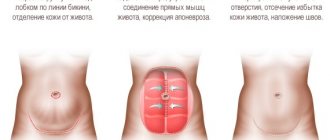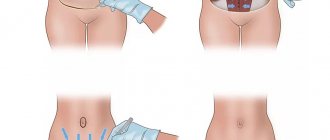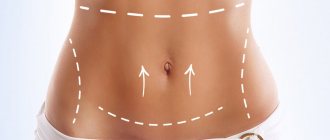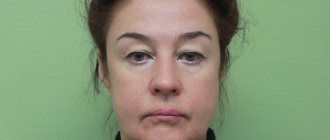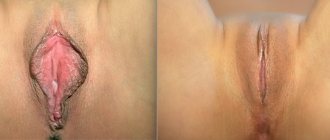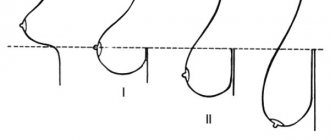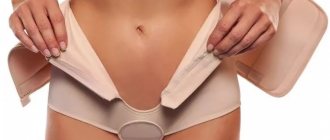Pregnancy is a difficult period for the body, which is characterized by multiple changes. Hormonal levels are disrupted, the position of internal organs changes, and body weight increases. Finally, volumes change, especially in the abdominal area.
After the birth of a child, the following consequences may be observed:
- excess skin;
- fat deposits in the abdomen and sides (flanks);
- separation of the abdominal muscles - diastasis;
- stretch marks.
If a cesarean section was performed, a long postoperative scar is added to the points listed above.
There are many non-surgical ways to restore your figure after childbirth. This is a gradual introduction to systematic sports, skin care using home remedies, and cosmetic procedures aimed at modeling toned body contours. But not all women manage to put their bodies in order in this way.
- First of all, everyone has different genetics. Accordingly, the process of restoring and strengthening the skin goes better for some, and worse for others.
- Secondly, if your skin is prone to stretch marks, you won’t be able to remove them after the fact.
- Thirdly, many women gain weight after childbirth, and the volume does not decrease. Finally, muscle separation can occur even in the most athletic girls, and cannot be eliminated with the help of fitness and proper nutrition.
The surgical method of abdominal correction is called abdominoplasty. This operation is designed to restore the previous shape and volume of the abdomen and sides. Plastic surgery is the most effective way to regain a beautiful figure. Women come to us after one, several or more births, and in all cases, surgery allows them to achieve the desired result.
Why is this operation so in demand? After the birth of a child, a woman worries about changes in her figure, her self-esteem drops, and discord arises in her intimate life with her husband. Abdominoplasty returns everything to its place, and literally too. The plastic surgeon acts as a real “wizard”, giving confidence in himself and his attractiveness.
Indications for abdominoplasty
excess skin;
decreased tone of the abdominal wall muscles;
muscle separation;
changes in tissue in the navel area;
stretch marks;
“apron” is a fold on the front of the abdomen that may extend to the sides.
Your therapist may recommend abdominal correction after childbirth for medical reasons (diastasis). But often this is simply aesthetic surgery to restore self-confidence.
During abdominoplasty the following is removed:
- excess skin;
- adipose tissue;
- periumbilical hernia (if present).
The doctor stitches the separated muscles together. Thanks to this, the shape of the abdomen is restored, it ceases to be round and protruding. Muscle suturing is also necessary to restore normal functioning of internal organs and to avoid the risk of hernias. Diastasis can also lead to urinary incontinence, constipation, shortness of breath, etc.
Suturing of diastasis
Usually one incision is made - in the lower abdomen. Multiple incisions are common when hernias are removed.
Rehabilitation period after abdominoplasty
At the request of my readers, I decided to write an article about the rehabilitation period after abdominoplasty. Abdominoplasty is an operation during which excess skin and fat is removed after severe weight loss or pregnancy, with or without moving the navel, depending on the amount of excess skin and fat and the degree of ptosis (sagging). In any case, this is a complex operation, followed by a rather long and difficult rehabilitation period, which I will tell you about in as much detail as possible today.
Just in case, although I have already written a lot about this in other articles, I will repeat again: abdominoplasty is not a means for losing weight ! And not a way to treat obesity. Abdominoplasty is an operation in which excess skin and fat tissue is removed after severe weight loss or childbirth. As a rule, before abdominoplasty, they lose weight to the desired level, and then turn to a plastic surgeon to normalize the stomach: tighten the skin and give the stomach a shape. But, if it is impossible to lose weight and if there is a so-called “apron” (sagging belly), abdominoplasty is still performed, and as a result of the operation, the appearance and quality of life improves. If you want to reduce body weight before surgery, then your primary task is to solve the problem of excess weight through consultation with a nutritionist, exercise and proper nutrition.
After abdominoplasty
After the operation, you need to spend about 2 days in the clinic under the supervision of a doctor. A team of doctors will monitor your recovery from anesthesia and your condition after surgery. For 2 to 5 days after surgery, you will have drainage tubes in your abdomen to drain fluids. If necessary, you may be sent home with drains.
The first thing you should know about the results of abdominoplasty is that they can be assessed no earlier than 6 months after the operation, when the swelling has completely subsided and the postoperative scar has healed. The swelling lasts for quite a long time, so it is better to immediately prepare for the fact that the stomach will not be flat in the first few months - precisely because of the swelling, this is not the final result of the operation, please be patient and wait for it to go away.
Compression bandage
If you want to get a smooth, flat stomach without unevenness or folds, then for 2 months after surgery it is recommended to wear a bandage and special post-operative compression garments - this greatly promotes proper healing and giving your stomach the desired shape.
The bandage not only helps to achieve the desired flatness of the abdomen, but also significantly relieves pain after surgery, evenly distributing the load on the abdominal and back muscles. The wider and better quality the bandage is, the more it will make your life easier: now there are high bandages from the knee to the chest, which help to avoid the process of undressing and dressing, and very well support the stomach in the desired position. Due to the need to wear a bandage, some people prefer to have abdominoplasty done during the cooler seasons - autumn, winter or spring, since walking in a bandage in hot weather is not very comfortable.
In the first days after surgery, while there are drainages, a postoperative bandage is required:
When the drains are removed, you can switch to compression garments:
Dressings and activity
You will need to come for dressings once a week. If necessary, more often. You can return to your normal life in 5-7 days - do not very difficult chores around the house or at work, if it is not related to physical activity.
After 2-3 months, you can resume sports and moderate cardio training, but very carefully, wearing a compression bandage. You can fully engage in sports and strength training no earlier than 4-6 months after surgery.
Edema
To ensure that the fluid around the suture does not stagnate and the swelling goes away faster, during the rehabilitation period it is necessary to do lymphatic drainage massage and adhere to a normal (moderate) diet in order to maintain weight and not allow it to grow or fall significantly. The permissible amplitude of weight fluctuations is 2-3 kg. Lymphatic drainage massage is recommended to be done periodically throughout the recovery period. The best effect can be achieved by combining hardware and manual massage. With the help of lymphatic drainage massage, lymph stagnation in the suture area is eliminated, and therefore the swelling goes away faster. Microcurrent therapy is also recommended as an additional procedure to promote faster healing.
Scar after abdominoplasty
The scar after abdominoplasty is large, since the incision is made between the pelvic bones in the lower abdomen, literally “from bone to bone,” but in such a way that the postoperative scar can be hidden under underwear. In the first few weeks after the operation, the scar will heal: it will get wet, become crusty, and all this will be accompanied by unpleasant sensations, which, unfortunately, are an integral part of the healing process of any wound. And a scar, in essence, is just that – a wound, albeit carefully stitched up. A year after the operation, the seam will become much lighter and will be almost invisible. In order to speed up the healing process of sutures, you can smear the sutures with silicone gels.
Scar after abdominoplasty
Pain
The pain (especially the first time after surgery) is quite intense, but much will depend on how easily you tolerate the pain and how high your pain threshold is. It also depends on the accompanying procedures: if liposuction was also performed during abdominoplasty, the pain may increase, since the intervention area is larger than with abdominoplasty without liposuction. Therefore, during the recovery period after surgery, especially in the first few weeks, you will definitely be prescribed painkillers: they help, and the postoperative period is easier.
Complications
Possible complications after surgery: fistulas along the surgical wound; necrosis of the skin-fat flap; inflammatory processes. You can minimize the risk of postoperative complications by following your doctor’s recommendations as closely as possible: regularly change dressings, properly handle sutures, avoid physical activity, direct exposure to ultraviolet rays, etc.
FAQ
Is it possible to give birth after abdominoplasty?
After abdominoplasty, contrary to popular belief, you can carry and give birth to a child - but not earlier than 2 years after the operation. However, pregnancy and childbirth can nullify the results of the plastic surgeon’s work and the operation will have to be repeated. Therefore, if you are planning pregnancy and childbirth, it is better to give birth first, and then contact a plastic surgeon, so as not to go through this difficult ordeal several times.
Is it possible to have abdominoplasty after a caesarean section?
Yes, tummy tuck surgery can be performed after childbirth via cesarean section.
What type of anesthesia is used and how long does the operation last?
To perform abdominoplasty, spinal anesthesia is most often used, general anesthesia (anesthesia) is also used, the operation lasts about 2 hours.
Is surgery done if I have diastasis?
Yes, it is done, the diastasis is sutured.
How much does abdominoplasty surgery cost?
- I degree - 150,000 rub.
- II degree - 200,000 rub.
- III degree - 230,000 rub.
- Consultation - 1,000 rub.
- The cost of anesthesia is determined on the day of consultation and depends on the volume of the operation.
If you still have questions, you can ask them in the “question-answer” section.
An appointment for a consultation with plastic surgeon Alexander Panaetovich Panaetovich in Moscow can be made by calling +7 (968) 328-66-44 (viber, whatsapp) or through the feedback form on the website:
Complex postpartum plastic surgery
Tummy tuck + liposuction
If we talk about the abdominal area, then after the birth of a child, many patients need not only to get rid of excess skin and remove stretch marks, but also to eliminate the resulting fat deposits. In this case, we offer the “abdominoplasty + liposuction” complex. The operation can be carried out either specifically in the abdominal area or involving the area of the flanks - sides.
Tummy tuck + breast lift
This type of correction is very popular, since the breasts suffer no less after pregnancy and breastfeeding. The mammary glands droop, stretch marks appear, and the nipples begin to look down. These shortcomings can be eliminated through mastopexy - surgical lifting of the mammary glands. If necessary, a lift + reduction mammoplasty is performed - if a woman wants to reduce her breast size.
Restoring the shape of the abdomen and chest at the same time is a very good idea, since there is no need to “go to bed” a second time under general anesthesia.
Tummy tuck + liposuction + breast lift
This operation lasts a long time (at least 4-5 hours), but after it the patients feel completely renewed. It allows you to solve all aesthetic issues at once.
Abdominal wall hernia. Why is it better to contact a plastic surgeon for this?
Abdominal wall hernias can occur for various reasons: as a result of congenital muscle weakness, after pregnancy or surgery. In any case, it is better to solve this problem with a plastic surgeon. Moreover, you should only contact a specialist in the field of abdominoplasty. Because (contrary to popular opinion) a hernia is, in addition to an aesthetic defect, also a real problem that can cause strangulation of the intestine and serious complications (including death).
Dr. Bakov is perhaps the best specialist in this field. Being a recognized expert in the field of abdominoplasty, he at the same time also has extensive experience in abdominal surgery. Thus, you can be sure not only of the absence of visible postoperative scars, but also of the high quality of the operation to eliminate the umbilical hernia and other abdominal wall hernias.
The following surgical correction techniques may be offered to you:
- umbilical hernia repair
- postoperative hernia repair
- ventral hernia repair
In difficult cases, to strengthen the abdominal wall and prevent relapse, a special polypropylene mesh is used, which allows not only to eliminate an abdominal wall hernia , but also to create a basis for your own connective tissue, which will strengthen the weak muscle frame. Such an operation will eliminate the risk of a pinched hernia, return you to a beautiful flat abdominal shape and restore the correct position of the internal organs.
Benefits of plastic surgery after childbirth
the surgical method of modeling the figure is the most effective;
the procedure is carried out under general anesthesia - while you sleep, doctors work to restore the aesthetics of your body;
the result is visible immediately after the operation;
the abdominal area looks natural;
the separated muscles occupy the correct, physiological position;
if a caesarean section was performed, part of the scar is excised along with excess skin; the remaining scar can be sanded down along with postoperative scars later;
the ability to get rid of all disturbing changes at once.
Cons of postpartum plastic surgery
very long recovery period;
the operation has many contraindications;
prices for abdominoplasty in Moscow are quite high.
Indications and contraindications for surgery
Performing abdominoplasty in Moscow is a serious surgical intervention. It can only be performed if there are appropriate indications.
When is the operation performed:
- Diastasis is muscle stretching along the white line. It is impossible to eliminate such a defect using conservative methods.
- A sharp decrease in body weight. Excess skin fat can be removed through surgery.
- Diagnosis of hernia.
Surgery is not performed if diseases of the cardiovascular system or nervous system are detected. Diabetes mellitus, inflammation, pregnancy, blood diseases, and autoimmune pathologies become limitations to plastic surgery. Only a doctor can determine the possibility of an operation.
Before calculating the cost of tummy tuck, you need to consult a doctor and assess the scale of the work. After the initial examination and medical history, if there are no restrictions, appropriate tests are performed.
Cost of abdominal correction after childbirth
The price for postpartum tummy tuck depends on the extent of surgery. Mini abdominoplasty of the peri-umbilical area costs 100,000 rubles. Full abdominoplasty with navel relocation costs 220,000 rubles. If liposuction is also required, the cost of the operation will increase.
Many women think that surgical restoration of the abdomen is not the most affordable, from a financial point of view, method of correction. Remember that this is not true: it is cost-effective both in terms of time (after the operation, the result remains with you forever) and in terms of finances (you will collectively spend much more on personal training, expensive creams, etc.).
To find out how much abdominoplasty costs in your case, make an appointment with a surgeon. The doctor will tell you about the specifics of the operation, the cost of anesthesia and consumables, the necessary tests and medications. In our clinic, doctors Anzhelika Vladimirovna Nikolaeva-Fedorova and Levan Leonidovich Valiev perform surgical correction of the abdomen. Since 2002, the Medial clinic has been helping women restore body aesthetics after childbirth and regain self-confidence.
Taking care of the health and beauty of the body is an important component of a harmonious life. Come visit us to make your dreams come true!
Do women often turn to a surgeon to undergo abdominoplasty after childbirth?
95% of my patients who underwent abdominoplasty are mothers, in some cases with many children. Often. The remaining 5% are patients with a history of massive weight loss. The resulting excess skin can only be eliminated through surgical correction.
If you still have questions about abdominoplasty, sign up for an in-person consultation with Kh.M. Kardov. by phone 8 (812) 407-33-66 or consult remotely by email
3
0
Rehabilitation
After a tummy tuck after a natural birth or cesarean section, the woman remains in the plastic surgery clinic for 24 hours. Bed rest is indicated for 3 days.
To prevent pain after surgery, the patient is recommended to take painkillers. It is also necessary to wear compression garments, which will relieve tissue swelling. Physical activity, sleeping on the stomach, visiting the bathhouse, swimming pool and sauna are prohibited. You cannot sunbathe in the sun or in a solarium.
How is the operation performed?
The operation is performed under general anesthesia strictly on an empty stomach. This is an important condition, since the operation can only be performed on an empty stomach. Markings are made in advance in a vertical position to mark the incision line and the amount of skin that needs to be removed.
The anesthesiologist administers anesthesia and monitors the patient's condition during the operation. The operation area is treated with antiseptics. This stage is important, since proper processing will avoid complications.
The duration of abdominoplasty can be up to 4.5 hours. The operation ends with the application of a bandage to the stitches. The patient is taken out of anesthesia and needs to stay in the clinic for some time. The patient's condition is monitored in the hospital throughout the day. After the intervention, you will need to wear compression garments and change dressings regularly. During the consultation, the doctor will talk about the features of recovery and give recommendations.
Abdominoplasty techniques
The surgical technique depends on the indications and can be performed in various variations:
Classical
The operation is performed when it is necessary to remove significant amounts of excess skin, correct the waist line and the location of the navel, and eliminate diastasis (muscle separation). This type of plastic surgery allows you to effectively bring your stomach into shape, reducing up to 70 cm of excess tissue. The cosmetic seam is located below the line of wearing underwear and is invisible to others.
Partial
It is considered less traumatic and is performed when it is necessary to tighten the skin in the lower abdomen without transferring the navel. When performing partial abdominoplasty, the seam is also located below the line of wearing underwear and also remains invisible to others.
Endoscopic
This type of abdominoplasty will not help get rid of the skin-fat “apron” and is indicated only if there is a slight weakening of the abdominal tone and separation of the abdominal muscles. Plastic surgery is performed without incisions, the intervention occurs through small punctures (2-3 cm), leaving no traces of the operation.
If necessary, the procedure can be performed in combination with liposuction (removal of local fat deposits).
The choice of the final tummy tuck procedure is determined by the surgeon during a face-to-face consultation.
